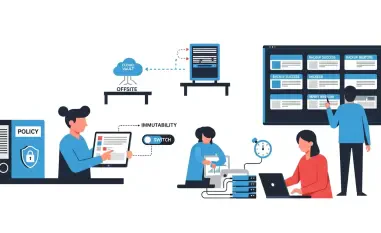The Evolving Landscape of Cybersecurity and Quantum Computing
Imagine a world where the most secure encryption protecting sensitive data could be unraveled in mere seconds by a machine far beyond traditional computing capabilities. This scenario is no longer a distant sci-fi plot but a looming reality with the advent of quantum computing, which threatens to disrupt the cybersecurity industry at its core. As enterprises grapple with increasingly sophisticated cyber threats, the rise of quantum technology introduces a new layer of risk, capable of breaking conventional cryptographic systems that safeguard digital transactions and communications.
The cybersecurity sector today is at a pivotal juncture, with key players like Palo Alto Networks leading the charge to address these emerging dangers. The industry is witnessing rapid technological advancements, driven by the proliferation of multi-cloud architectures and AI-driven environments that add complexity to security frameworks. Companies are compelled to adapt to a landscape where data breaches can cost millions and reputational damage can be irreparable, pushing the demand for innovative solutions that anticipate future vulnerabilities.
Quantum computing stands out as a game-changer, with its potential to solve complex problems at unprecedented speeds. However, this power also poses a significant threat to current encryption standards, necessitating a shift toward quantum-resistant technologies. Palo Alto Networks, among other industry leaders, is at the forefront of developing strategies to mitigate these risks, ensuring that enterprises are not left defenseless against the next wave of cyber challenges.
Palo Alto Networks’ Strategic Response to Quantum Threats
Innovative Tools for Quantum Readiness
Palo Alto Networks has taken a proactive stance in preparing enterprises for the quantum era by introducing cutting-edge tools designed to assess and fortify cryptographic defenses. One such innovation is the Quantum Readiness Dashboard, seamlessly integrated into their Next-Generation Firewall (NGFW) and Secure Access Service Edge (SASE) platforms. This dashboard provides organizations with a clear view of their cryptographic vulnerabilities, enabling them to prioritize and address potential weaknesses before they can be exploited.
In addition to visibility tools, the company offers a groundbreaking encryption translation solution that updates applications to quantum-secure standards without requiring extensive redevelopment. This tool is particularly vital for businesses relying on legacy systems that are not inherently compatible with post-quantum cryptography (PQC). Furthermore, Palo Alto Networks has rolled out 14 new fifth-generation NGFW models, engineered to handle PQC processing with high performance, ensuring that hardware investments remain relevant in a quantum-threat landscape.
These advancements underscore a commitment to cryptographic agility, a critical factor in staying ahead of quantum risks. By combining software and hardware innovations, Palo Alto Networks equips organizations with a comprehensive toolkit to transition smoothly into a secure future, protecting sensitive data against threats that are no longer hypothetical but increasingly imminent.
Market Impact and Industry Adoption
The market potential for quantum-ready solutions is vast, as enterprises across sectors recognize the urgency of preparing for quantum advancements. Analysts project significant growth in the adoption of quantum-resistant technologies over the next few years, with estimates suggesting a compounded annual growth rate that could reshape cybersecurity budgets from this year through 2027. Palo Alto Networks is well-positioned to capture a substantial share of this expanding market, given its early mover advantage and robust offerings.
Industry leaders have echoed the need for immediate action, emphasizing that delaying preparation could leave organizations exposed to catastrophic breaches once quantum computers become widely accessible. The integration of quantum readiness tools into existing security infrastructures is seen as a practical step, particularly for industries handling critical data, such as finance and healthcare, where the stakes of a security failure are exceptionally high.
Adoption rates are expected to accelerate as awareness grows and regulatory pressures mount, pushing companies to prioritize quantum security. Testimonials from major partners, including high-profile organizations in sports and travel technology, highlight the real-world applicability of these solutions, reinforcing confidence in Palo Alto Networks’ ability to deliver scalable and effective defenses against future threats.
Addressing Challenges in Multi-Cloud and AI Environments
The rapid shift to multi-cloud architectures has transformed how enterprises operate, offering flexibility but also introducing significant security challenges. Fragmented environments often result in blind spots and inconsistent policies, making it difficult to maintain a cohesive defense strategy. When coupled with the integration of AI technologies, these setups become even more complex, as automated systems can inadvertently amplify risks if not properly secured.
Palo Alto Networks addresses these issues with tailored solutions like the AI and Cloud Network Risk Assessment tool, which continuously monitors cloud and AI assets to identify vulnerabilities. This tool provides actionable recommendations for implementing necessary security controls, ensuring comprehensive protection across diverse platforms. Additionally, automated deployment of software and cloud firewalls minimizes human error and enhances response times to potential threats.
Another key offering, Prisma AIRS, configures cloud infrastructures into a secure multi-cloud network mesh, scaling dynamically to meet demand. With native load balancing and a design that eliminates the need for supplementary tools, this platform simplifies operations while bolstering security. Such innovations demonstrate a keen understanding of the operational hurdles enterprises face, offering a pathway to maintain agility without compromising on protection.
Regulatory and Compliance Considerations for Quantum Security
As quantum computing advances, the regulatory landscape surrounding data encryption and cybersecurity standards is evolving rapidly. Governments and international bodies are beginning to draft guidelines that mandate the adoption of quantum-resistant encryption, recognizing the potential impact on national security and economic stability. These emerging policies aim to ensure that organizations are not caught off guard by sudden shifts in threat capabilities.
Palo Alto Networks aligns its solutions with these developing compliance requirements, providing enterprises with the tools to meet current and anticipated standards. By embedding features that support cryptographic transitions and offering detailed risk assessments, the company helps businesses navigate the complexities of regulatory adherence, reducing the burden of future-proofing their security measures.
This alignment is particularly crucial for industries subject to stringent data protection laws, where non-compliance can result in hefty fines and legal repercussions. The proactive integration of compliance-ready features into security platforms ensures that enterprises can focus on their core operations, confident that their defenses are equipped to handle both technological and regulatory challenges in the quantum era.
The Future of Cybersecurity in a Quantum World
Looking ahead, the cybersecurity industry is poised for transformative changes driven by the broader adoption of quantum-resistant encryption. As more organizations recognize the limitations of traditional cryptographic methods, the push toward PQC and other innovative standards will likely accelerate, reshaping how data security is approached on a global scale. This shift represents both a challenge and an opportunity for technology providers to lead with groundbreaking solutions.
Automation in security operations is another trend gaining momentum, promising to streamline threat detection and response in increasingly complex environments. However, potential disruptors, such as geopolitical tensions or uneven technological access, could influence the pace of adoption and the direction of innovation. Economic factors, including budget constraints in certain regions, may also play a role in determining how quickly quantum-ready technologies are deployed.
Global technological shifts, such as advancements in AI and the expansion of cloud services, will continue to intersect with cybersecurity needs, creating a dynamic landscape where adaptability is key. Companies that invest in research and development to anticipate these changes will likely emerge as leaders, setting the stage for a future where security is not just reactive but inherently predictive and resilient against emerging threats.
Conclusion: Palo Alto Networks as a Leader in Quantum-Ready Security
Reflecting on the comprehensive strategies employed by Palo Alto Networks, it becomes evident that their approach to quantum threats and multi-cloud challenges marks a significant milestone in cybersecurity evolution. Their innovative tools and scalable platforms provide enterprises with much-needed defenses against sophisticated risks that were once considered distant. The emphasis on cryptographic agility and regulatory alignment offers a robust framework for organizations navigating an unpredictable digital terrain.
Moving forward, enterprises are encouraged to prioritize quantum readiness by leveraging solutions like those from Palo Alto Networks to assess and fortify their security posture. A critical next step involves fostering collaboration between industry stakeholders to share insights and best practices, ensuring collective resilience against quantum advancements. Additionally, continuous investment in automation and risk assessment tools is seen as essential to maintaining agility in multi-cloud and AI-driven environments, paving the way for a more secure digital future.













